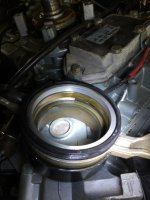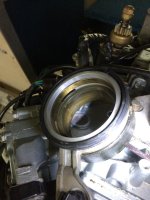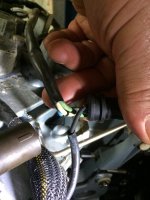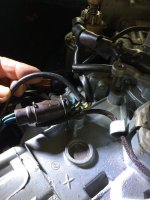Last fall I acquired '85 Sylvan Fish & Ski with a 90hp Evinrude E90TLCOS. First several outings it ran fine (this season) both at idle and cruising at 5200 rpm. Last weekend it developed a noticeable miss that seemed to disappear at higher rpm. While attempting to put it on the trailer it started the missing and stalled. Being it was on the trailer and dark I went home. [ Back up a week ~ Prior to the outing I was also experiencing a soft fuel bulb that didn't seem to want to pump up hard. I installed an anti-siphon valve on the top of the tank delivery line to the engine. I also found a leaking line from the fuel manifold to the primer pump which I replaced and didn't observe any other leaks.] So now I'm thinking the miss was due to fouled plugs or possibly week spark. I pulled the plugs and they all looked pretty good. While they were out I did a compression test and an 'open air' spark test. Compression was 110 to 108 and the spark look very strong. So I was thinking my miss was related to the poor fuel delivery with the soft bulb. I extended the fuel line to enable me to mount the fuel bulb vertically and replaced the fuel bulb. It did eliminate the solf fuel bulb issue and thought all would now be good. Today at the ramp the engine would start rather easily but then die. I could keep it running by giving it a 'shot' with the primer pump and after it warmed up it ran on its own but was missing. When I would lower the fast start lever and attempt to put it into gear it would die. I did finally get it into reverse and backed off the trailer. I pulled away and was going to blow out the cobwebs so to speak and found I had very little flat acceleration..maybe 2000 rpm. I turned right back and put it back on the trailer. Now I'm scratching my head. I've got new carb kits I was going to use this winter but maybe nows the time? Thoughts? Suggestions?
Home
Outboard Motor Parts
Chrysler outboard parts Evinrude outboard parts Force outboard parts Honda outboard parts Johnson outboard parts Mariner outboard parts Mercury outboard parts Suzuki outboard parts Tohatsu outboard parts Yamaha outboard partsInboard & Sterndrive Engine Parts
Chrysler Marine inboard parts Crusader Marine parts MerCruiser sterndrive parts OMC sterndrive parts Pleasurecraft Marine parts Volvo Penta marine parts + MoreAll Engine Brands
All Manuals HomeOutboard Repair Manuals
Chrysler outboard manuals Evinrude outboard manuals Force outboard manuals Honda outboard manuals Johnson outboard manuals Mariner outboard manualsMercury outboard manuals Nissan outboard manuals Suzuki outboard manuals Tohatsu outboard manuals Yamaha outboard manuals
Inboard & Sterndrive Engine Manuals
MerCruiser sterndrive manuals OMC sterndrive manuals Volvo Penta marine engine manualsPlease Note
MarineEngine.com does not offer troubleshooting assistance or repair advice by email or by telephone.
You are invited to join our public Boat Repair Forum to seek assistance from other members.
You may also visit the Boat Motor Manuals section of our site to obtain a service manual.





